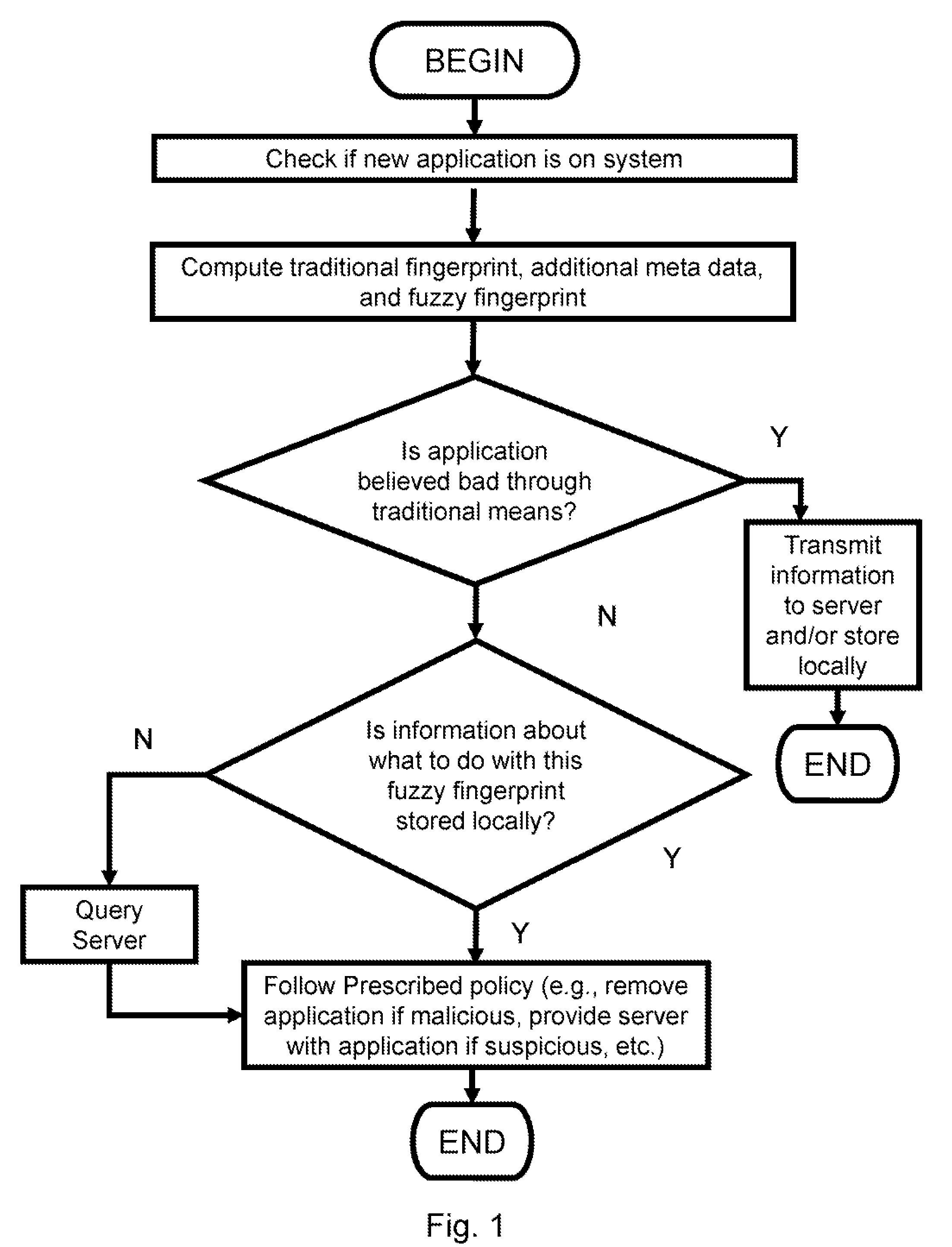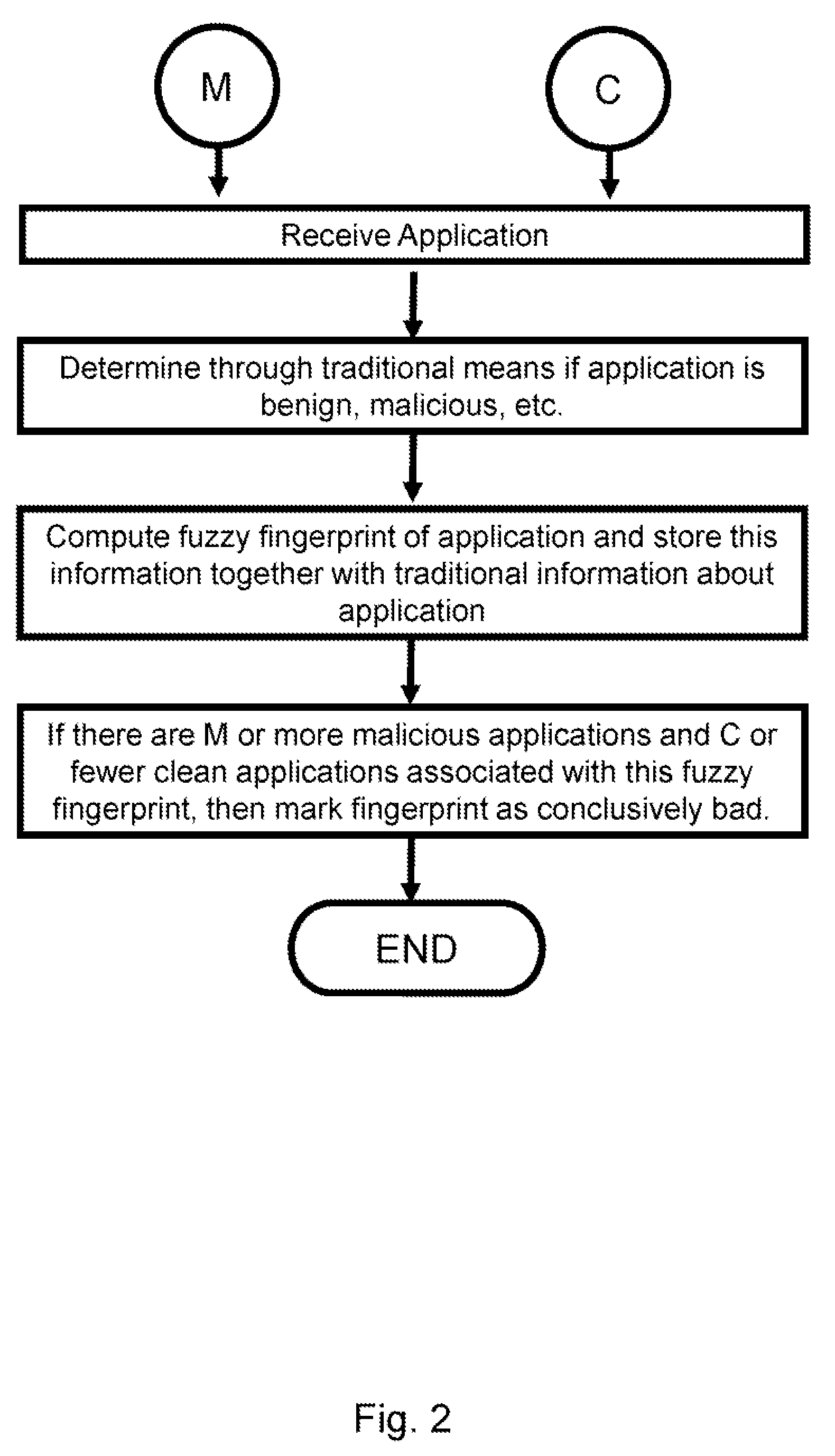Method and apparatus for detecting malicious software through contextual convictions, generic signatures and machine learning techniques
a malware and contextual conviction technology, applied in the field of malware detection, can solve problems such as application potential evasion, theft of data from the system, and compromise the security of general computing devices, and achieve the effect of simple respons
- Summary
- Abstract
- Description
- Claims
- Application Information
AI Technical Summary
Benefits of technology
Problems solved by technology
Method used
Image
Examples
generic signatures embodiment
[0069]In one embodiment of the present invention, the client and server components would function as follows. The server would engage in an optional initialization phase wherein it would compute a fuzzy fingerprint on both known malicious and known clean files. These results would be stored in a data store such as a traditional database or even in a flat file. The algorithm for computing the fuzzy fingerprint could be any one known in the art, examples of which include PEHash and ssdeep. Alternatively, a manual or custom algorithm can also be employed. The choice of fingerprinting implementation does not impact the reduction to practice of the invention so long as the choice is consistent (i.e., the client and server use the same algorithm).
[0070]If the server has determined that there is sufficient evidence that the fuzzy fingerprint is conclusively bad (for example, if there are a large number of known malicious applications that have this same fingerprint and no known good applic...
example 1
[0077]Example 1 is provided to illustrate one aspect of the invention. This example illustrates one possible work flow according to the invention and is intended to help make the invention more clear. It is not meant to restrict the invention in any way since there are numerous variations not described in Example 1 that nevertheless fall within the scope of the overall invention, but which are left out of the Example 1 to avoid obscuring it.
[0078]According to Example 1, a client and a server are provided. A new software application arrives on the client. The client computes both a generic and specific fingerprint on this file and transmits it to the server. The server examines both of these fingerprints. If from these two pieces of information alone, it knows the application to be either conclusively good or bad (e.g., the file is on a known blacklist or whitelist), then the server will return this disposition.
[0079]If no conclusive determination can be made from either of these two...
example 2
[0098]This example illustrates a specific instance of the invention, describing the steps and actions along the way. This example is provided to help clarify the description, and it should not be considered limiting in any way. For example, the above invention description covers many variations and extensions. To avoid obscuring the description, these variations and extensions are not discussed below.
[0099]To begin, consider a piece of agent software running on a user's machine. According to this example, the agent software contains a Microsoft Windows filesystem mini-filter driver that can detect when a new (executable) file is being written to the file system. Other software that can detect when a new executable file is being written to the file system can also be used. Following notification that there has been or is an attempt to write a file to the file system, the software agent computes two values. First, it computes a “traditional” fingerprint, such as a SHA-256, on the file...
PUM
 Login to View More
Login to View More Abstract
Description
Claims
Application Information
 Login to View More
Login to View More - R&D
- Intellectual Property
- Life Sciences
- Materials
- Tech Scout
- Unparalleled Data Quality
- Higher Quality Content
- 60% Fewer Hallucinations
Browse by: Latest US Patents, China's latest patents, Technical Efficacy Thesaurus, Application Domain, Technology Topic, Popular Technical Reports.
© 2025 PatSnap. All rights reserved.Legal|Privacy policy|Modern Slavery Act Transparency Statement|Sitemap|About US| Contact US: help@patsnap.com



